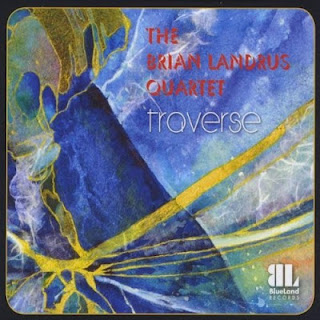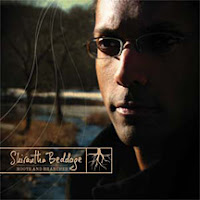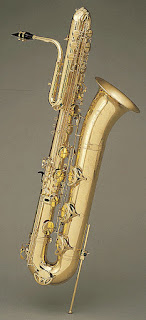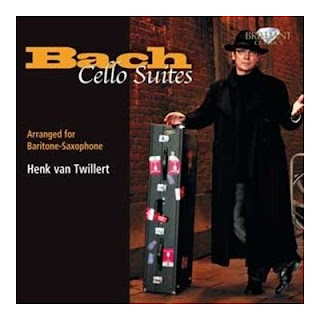Brian Landrus Quartet – Traverse
When I think of a sensual saxophone tone my first thoughts lean towards the sultry tenor playing a bluesy piece in smoke filled club as people drink hard liquor and snap their fingers. Sure it’s cliched but until I heard this album I was pretty comfortable with that vision. After listening to Brain Landrus’ amazing sensitivity I knew that I would have to expand my vision to include the baritone as a “saxually” capable instrument.
 In keeping with my love of unique voices and tone I have to lead this review with a discussion of tone, and what a tone it is. His baritone tone is close up and intimate. It lacks the strong projection and distinct buzz easily identified with more modern setups. In fact I was so sure that he was playing a Otto Link that I had to visit his website to confirm. Wouldn’t you know, yes he does play several Links. Personally I have always loved the compact and centered, though somewhat stuffy, tone links bring to the baritone sax.
In keeping with my love of unique voices and tone I have to lead this review with a discussion of tone, and what a tone it is. His baritone tone is close up and intimate. It lacks the strong projection and distinct buzz easily identified with more modern setups. In fact I was so sure that he was playing a Otto Link that I had to visit his website to confirm. Wouldn’t you know, yes he does play several Links. Personally I have always loved the compact and centered, though somewhat stuffy, tone links bring to the baritone sax.
For a great example of spectrum of Landrus’s tone listen to “Soul and Body”. This unaccompanied solo takes the listener on a journey. Visiting advanced techniques like multiphonics, split tones, subtones, and wide dynamic ranges. Landrus did this while still making the entire experience moving and musical. The piece is placed just ahead of “Body and Soul” on the album and adds another dimension to that oft recorded tune just by being in proximity.
Also on auditory display is Landrus on bass clarinet. I’ll admit that outside of Bob Mintzer, I have very little listening experience to bass clarinets in jazz. With that in mind feel free to take this and anything else I say with a grain of salt. With the disclaimer stated I will say that his ability to tell a story is equal on bass clarinet as it is on the baritone saxophone. Landrus displays fantastic control and expressiveness. The way Landrus presents the bass clarinet makes it feel like the brother to the baritone saxophone and not like a gimmick. The two tones compliment without showing the other up.
As you might imagine, Landrus didn’t do it alone. He is accompanied by what I can only describe as some of the most sensitive and aware musicians available. Simply listen to Michael Cain on the track “Lone“. His use of empty space and a quiet confidence pushes the track along in a way that makes you long to hear how Landrus will fill the spaces when he comes in later. Simply put this track is sexy and just a bit melancholic.
Lineup:
Brian Landrus – Baritone Saxophone, Bass Clarinet
Lonnie Plaxico – Acoustic Bass
Michael Cain – Acoustic Piano
Billy Hart – Drums
TAKE AWAY: Buy this album. That’s it! Nothing more, just buy it. It’s worth the money at 2x the price to have a great musician playing originals and standards on demand from your CD player. At the very least you have a stellar example of what a vintage Link and Mk VI bari can do in the hands of an expert.
Brian’s website: Brianlandrus.com
Get this from Amazon like I did:
Traverse***
Correction
*** – It has been brought to my attention that Brian may have been playing a Lebayle AT mouthpiece on this recording. If so I can say that I am excited to play one of these pieces as it seems to have the qualities of a Otto Link but with something unique to Lebayle. I hope to get the chance to play one of these pieces myself soon.
 Few albums make me want to find the player and enroll in his college but this album makes a great case for Beddage’s music department at Humber College (Toronto, Canada). Beddage proves wrong the Mencken quote that “those who can, do; those who can’t, teach”. It is clear that his love and passion for music has given this album its shine.
Few albums make me want to find the player and enroll in his college but this album makes a great case for Beddage’s music department at Humber College (Toronto, Canada). Beddage proves wrong the Mencken quote that “those who can, do; those who can’t, teach”. It is clear that his love and passion for music has given this album its shine. Few albums make me want to find the player and enroll in his college but this album makes a great case for Beddage’s music department at Humber College (Toronto, Canada). Beddage proves wrong the Mencken quote that “those who can, do; those who can’t, teach”. It is clear that his love and passion for music has given this album its shine.
Few albums make me want to find the player and enroll in his college but this album makes a great case for Beddage’s music department at Humber College (Toronto, Canada). Beddage proves wrong the Mencken quote that “those who can, do; those who can’t, teach”. It is clear that his love and passion for music has given this album its shine.












